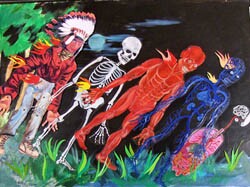Martha Colburn: Triumph of the Wild

Deliriously manic yet bluntly critical, Martha Colburn's dazzling, colorful animations hit you on the head, skewer you through the gut, and lift you away on wisps of soft, billowy air. Her 10-minute Triumph of the Wild, for example, references the iconic portrait of state power in Triumph of the Will from 1934, replacing Leni Riefensthal's paean to grace and symmetry with chaos and disorder. The film marches from the American Revolution through two world wars and on to the gory present, using jittery jigsaw puzzles and faded drawings and paintings of hunters, soldiers, guns and wild animals engaged in bloody mayhem. A driving piano score elevates the sense of familiar patriotism such that the murder of animals makes you nothing less than queasy. Or uneasy. Or incredibly excited that the punk energy of an earlier generation of handmade films and videos is back! The New York City-based artist has been making her short, very artisanal animations since 1994, crafting a body of work built on essential American iconography, from pin-up pics to patchwork quilts, from shop catalogs to bits of fabric. All of her films boast extraordinary soundtracks - Electric Literature springs from Diana Wagman's story "Three Legged Dog" about the gaping expanse left by a lost breast and features Colburn's trademark barrage of imagery, but everything gets amped up nicely with Nick de Witt's textured, punching music.
In a fitting antidote to the fuzzy softness of Valentine's Day, Colburn will present a selection of her films on Monday, February 14 at REDCAT in a show titled "Animating Mayhem: Collage and Painted Films by Martha Colburn." The show starts at 8:30. With luck, the projectionist will turn the sound way up. Triumph of the wild, indeed.


